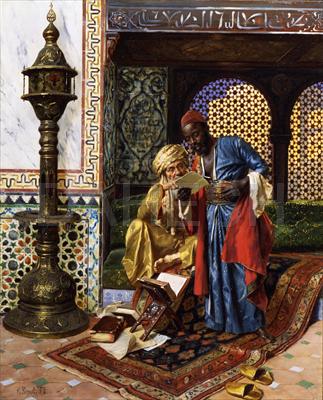Rudolf Ernst (Austrian, 1854–1932)
The Letter, 1888
Oil on panel, 25 3/4 x 21 in.
Signed and dated lower left: R. Ernst 88
1995.53

Like many of Ernst’s works, The Letter reveals an interior scene that demonstrates the artist’s skill at rendering diverse striking textures, surfaces, and color. The composition is filled with decorative details, ranging from intensely hued costumes, Islamic tile patterns, and rug, to the delicate woodwork of the bookstand, with its mother-of-pearl inlays, and mashrabiya screen—constructed with small pieces of wood turned to create a multitude of lattice-like patterns. His profuse details often blended architecture, objects, and costumes from diverse cultures, which at times compromised ethnographic accuracy. For instance, the Arabic script on the wooden beam over the two figures incorrectly copies the common phrase “There is no victor but God” and is also painted in reverse. Many of the motifs, including the bronze lamp and tile patterns, can be found in his other works, drawn from his large collection of Oriental artifacts.


